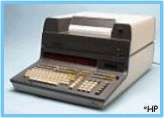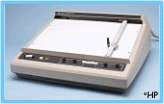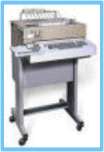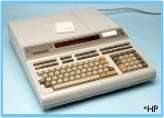
|
|
The HP-9830
Computer |
 |
|
The HP-9862
Plotter |
Programming systems for other manufacturing processes, such
as milling, turning, flame cutting and others already existed for some time,
mostly to be used on large mainframe computers. The first systems suitable for
wire EDM appeared on the market only in the early 70s. These systems did not
need to be as sophisticated as the others mentioned above, there was no
technology, feeds and tool changes to be taken into account. Furthermore, all
movements were restricted to the two main axes, normally named X and Y. This
means, that the available programming systems were requiring more information as
input data as needed for wire EDM, and also creating unnecessary output.
The chronology in which the first systems appeared and were adopted (if at all)
at AGIE is very difficult to reconstruct, the company took a long time to decide
what kind of programming support had to be offered to the final customer.

|
|
The HP-9830
Computer |
 |
|
The HP-9862
Plotter |
With the introduction of desktop computers, which were
powerful enough to shoulder this kind of application, a completely new marked
opened up for the manufacturers of programming systems.
The first computer making its appearance and suited for such an application was
most likely the HP9830 of Hewlett-Packard. This was a machine which could be
programmed in the programming language BASIC and which had a footprint not much
larger than a typewriter. In its standard version it was delivered with
"incredible" 4 Kbytes of memory available to the user, for a market
price of US$ 5'975.--. This base unit could be extended, with the appropriate
printed circuit board, to a maximum of 8 Kbytes, adding another US$ 1'475.-- to
the price tag. At the left hand side of the computer there was a small
compartment which could accommodate a number of ROMs, which were pre-programmed
for specific calculations, such as creating the output for a plotter, the
treatment of string variables, the output of data to other peripherals, etc..
Each of these ROMs had to be purchased separately and plugged in if necessary
for the application. In the standard configuration which could be used for the
programming of NC-controlled machine tools, the three above mentioned ROMs, for
a unit price of US$ 485.-- had to be included, as well as a printer (shown on
top of the computer in the image shown, US$ 2'975.--), a pen plotter (US$
2'675.--), a paper tape reader (US$ 1'470.--) and a paper tape puncher (from
FACIT, price unknown) had to be purchased, for total of approximately US$
12'000.--, not including the paper tape puncher and the necessary software.
As software, a product of a French developer was used, initially designed for
milling applications, and named ELAN-30. This software enabled the user for the
first time to define the geometrical elements and the sequence in which they had
to be traveled along, without having to care about the computation of
intersection and tangency points. Based on the computed data, a punched paper
tape was automatically produced, containing all the relevant information. A tape
cassette deck was incorporated in the computer, but the cassette had to be
inserted in the drive during computation, as several segments of the software
had to be continuously swapped because of the restricted memory. This paper tape
obviously contained a lot of data not needed for wire EDM, such as tool changes,
feed rates and movements in the Z-direction. This data was always punched, even
if completely ignored for the subsequent processing.
During a second run on the computer, the punched tape was read again, to be used
with a special postprocessor, transforming the general data into information
needed by the AGIECUT machines. The first of these postprocessors was actually
developed for the DEM-25, the wire EDM model which followed to the DEM-15, the
data needed by the first model seemed to complex for the French developer to
produce a usable postprocessor. This first postprocessor was developed as a
co-production between the French company and AGIE, in order to acquire enough
knowledge to develop any further postprocessors in house at AGIE.
In the programming department of AGIE the second postprocessor, this time for
the DEM-15, was developed, initially only for output in the codes ISO and EIA,
later also for the AGIECODE. In a second release, the postprocessor for this
machine also included a very sophisticated method to approximate the fractions
of degrees for circular arcs. By using elliptical arcs rather than circular
arcs, the fractions of degrees could be approximated with a much higher
accuracy. The still remaining tiny errors were accumulated at every calculation,
to be taken into account in the following instance, bringing the overall
accuracy to a never attained final result.
![]()
![]()
![]()
![]()
![]()
![]()
![]()
![]()
At some time in the same period, the first computing centers,
with its huge machines, tape drives, and air-conditioned rooms with double
floors opened, using a variety of computer models and brands. The first of these
centers, equipped with hard and software for the programming of NC-controlled
machine tools was located in the vicinity of Zurich, quite a distance from
Losone and Ticino, were such centers opened only much later. The geometry and
the machining sequences for the parts to be programmed had to be encoded in the
application software APT (Automatically Programmed Tools), or its clones. This
data was written down on specially created forms, to be punched into 80 column
punched cards to be fed into the computer. The machines to punch the cards were
available at AGIE for other applications, but always occupied for internal
needs, therefore the cards had to be punched on the units available at the
computing center.
Packing all the filled in forms into a briefcase, one had to travel to Zurich,
to first punch the cards. In the evenings, when the computer was not used for
other applications and the APT application could be loaded, the punched cards
were fed into the machine. The first run invariably resulted in a program stop,
caused by a punching or definition error. The error message was printed out and
had to analyzed, so that the erroneous punched cards could be corrected, before
starting a second run. The application software was still quite primitive, and
stopped the process whenever the first error was encountered. This means, that
the single errors had to be eliminated one by one, until the postprocessor could
be executed without any glitch. This resulted in a paper tape, punched on a high
speed puncher, put away with all the other successfully computed programs,
before boarding the train again to return to Losone.
![]()
![]()
![]()
![]()
![]()
![]()
![]()
![]()

|
|
The Olivetti |
A short time after this quite cumbersome solution, the first
computing centers offering computing possibilities at a distance opened,
enabling the users to access the computing power via a suitable terminal. Such a
terminal was therefore acquired and the personnel was trained in its operations.
Rather than punched cards, a paper tape was now used as data carrier, obviously
punched in the off-line mode, to save on expensive telephone connections.
To enable the communication with the remote computer, a modem had to be rented
as well from the local telecom company. The external dimensions of that unit
corresponded approximately to those of a desktop computer used today, with the
"incredible" transmission speed of 300 Baud, a terribly slow speed,
compared to the rates available nowadays. In order to guarantee a faultless
transmission of the data to and from the remote computer, a "clean"
telephone line was needed, not passing through a switchboard, always causing
some parasites and disturbances.
When the input program was punched on the tape, the communication with the
"time sharing" computer could be established, to transmit the data of
the program to be computed and to start the first run through the application
software. Here as well, the processing normally stopped at the first error that
was encountered, After some time, minor changes could be applied to the APT
software, enabling it to pass on after an error, delivering the appropriate
message, to be evaluated later by the programmer. These corrections could then
be executed at the desk, to start a new computer run once the new tape was
ready.
![]()
![]()
![]()
![]()
![]()
![]()
![]()
![]()
A company in England, which had acquired a DEM-15 for the
tool room, was active in the field of manufacturing computers. They decided to
develop their own version of a programming system, named AGIPAC (not to be
confused with any AGIE product), working in a dialog with the programmer.
Here as well, the programmer had to be connected with the computer via a
telephone line, to receive the questions and send the answers to the remote
computer, unfortunately located in England, increasing the cost of a program
generated by these means by a considerable amount, due to the high telephone
costs charged in those times.
This AGIPAC system was very short-lived, mostly because there were very few
computing centers which were equipped with the appropriate computer model, and
also available for remote access.
![]()
![]()
![]()
![]()
![]()
![]()
![]()
![]()

|
|
The HP-9825 |
After these first developments, innumerable other systems
followed, to enumerate them all would be virtually impossible.
In 1976, Hewlett-Packard introduced the new HP-9825, a desktop computer, not
larger than a typewriter, including a keyboard, display, special cassette deck
and a thermo printer. The programming language was one developed by HP, named
HPL and including features normally only available only on much larger systems.
AGIE first acquired one such computer, costing at that time US$ 5'900.-- without
the necessary peripherals, consisting of a pen plotter and a paper tape puncher.
This computer was made available to a department at the Swiss Technical University
(ETH) in Zurich, where a new programming system for the wire EDM machines had to
be developed.
The HP-9825 had a special feature, the so-called interrupt function, enabling
the computer to branch to a separate operation, when a determined signal was
received. The intention was to use the computer for the programming of a new
shape, whilst transferring available NC-code to the machine whenever it was
idle. This resulted in a continuous action on one of the special function keys
(F9) of the computer, before any input could be made. This solution was later
abandoned, as very few users were willing to place the computer close enough to
the machine, accepting the noisy and unfriendly environment of the tool room.
The programming system which resulted from this development was named LAMA-25,
following a certain line names adopted by the head of this development at the
ETH. This product, later along with its developer, was adopted by AGIE as its
standard package, offered and sold along with many of the wire EDM units sold
worldwide.